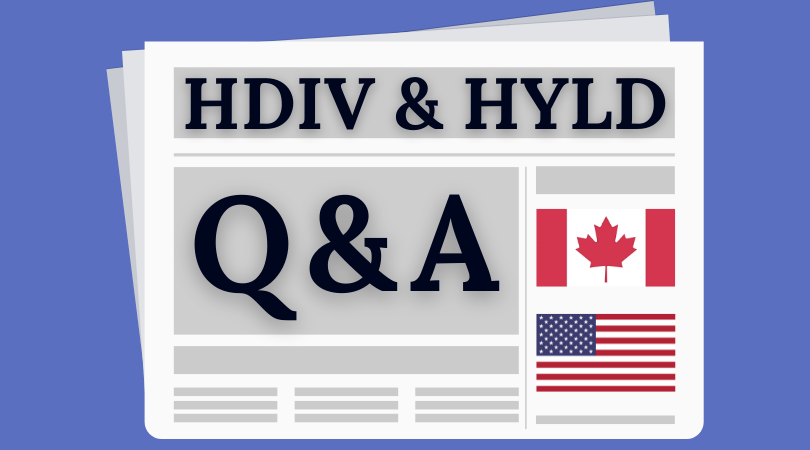1. What types of investors should consider the Hamilton Enhanced Multi-Sector Covered Call ETF (HDIV) and the Hamilton Enhanced U.S. Covered Call ETF (HYLD and HYLD.U)?
These two ETFs are designed for long-term investors seeking higher monthly income and sector diversification from Canadian equities (HDIV) and U.S. equity markets (HYLD and HYLD.U). These ETFs utilize modest 25% cash leverage to enhance yield and return potential. At launch, HDIV and HYLD had targeted yields of 8.5% and 10.0%, respectively. Over time, the yields of HDIV and HYLD should roughly approximate the average of the underlying funds, multiplied by 1.25x. HYLD offers distributions in either Canadian dollars (HYLD, CAD-hedged) or U.S. dollars (HYLD.U, USD-unhedged).
2. What are the key attributes of HDIV and HYLD?
HDIV and HYLD are both modestly levered funds comprised of primarily covered call funds. HDIV has exposure to 8 different Canadian equity focused ETFs. HYLD is similar, except it owns 8 higher-yielding U.S. equity focused ETFs. The investment objective of HDIV and HYLD is to provide attractive monthly income and long-term capital appreciation from a diversified portfolio of primarily covered call ETFs focused on Canada and the U.S, respectively[1].
HDIV and HYLD were constructed to have a sector mix broadly similar to the S&P/TSX 60 (TSX 60) and the S&P 500, respectively, but with higher yields and monthly distributions. Both ETFs have more diversification and less concentration risk than these large benchmark indices. For example, the ten largest exposures within the underlying portfolios/funds held by HDIV total ~20% versus ~50% for the top ten positions in the TSX 60. For HYLD, the ten largest exposures are ~20%, versus ~30% for the S&P 500.
3. What are the benefits of owning HDIV and HYLD/HYLD.U?
Supported by modest 25% leverage, HDIV and HYLD are designed to offer the following benefits to investors:
- Higher monthly income from a portfolio of higher-yielding, Canadian focused (HDIV) and U.S. focused (HYLD/HYLD.U) covered call strategies
- Higher potential long-term returns from modest 25% leverage, that also helps mitigate the yield/lower return trade off inherent in covered call strategies
- Sector exposures broadly similar to the TSX 60 (HDIV) or S&P 500 (HYLD), but with a significantly higher yield and lower concentration risk
- Provide investors exposure to modest leverage at institutional rates, which are materially lower than retail margin accounts
- Reduced risk of distribution reductions compared to individual sector covered call ETFs
- HYLD offers the option of distributions in Canadian dollars (hedged) or for HYLD.U in U.S. dollars (unhedged)
4. When are monthly distributions paid and what is the tax treatment of distributions?
In general, for our ETFs, the ex-dividend date is the second to last business day of a month, and the payment date for distributions is 6 business days after the ex-date. From a tax perspective, the composition of the underlying funds’ distributions will flow through to HDIV and HYLD investors. Distributions from covered call ETFs generally include eligible dividends, capital gains, foreign income, and a return of capital component. The composition of these distributions varies from year to year[2]. Distributions from HDIV and HYLD/HYLD.U are not subject to withholding taxes. The level of distributions reflects the fact that withholding taxes have already been paid by the underlying holdings (i.e., distributions are net of withholding taxes).
____
A word on trading liquidity for ETFs …
Hamilton ETFs are highly liquid ETFs that can be purchased and sold easily. ETFs are as liquid as their underlying holdings and the underlying holdings trade millions of shares each day.
How does that work? When ETF investors are buying (or selling) in the market, they may transact with another ETF investor or a market maker for the ETF. At all times, even if daily volume appears low, there is a market maker – typically a large bank-owned investment dealer – willing to fill the other side of the ETF order (at net asset value plus a spread). The market maker then subscribes to create or redeem units in the ETF from the ETF manager (e.g., Hamilton ETFs), who purchases or sells the underlying holdings for the ETF.
____
Recent Notes:
Hamilton ETFs Launches Hamilton Enhanced U.S. Covered Call ETF (February 7, 2022)
Questions and Answers on HDIV (Hamilton Enhanced Multi-Sector Covered Call ETF) (August 20, 2021)
Globe & Mail on HDIV: Canadian ETF tests conventions with high yield on a portfolio of quality stocks (July 21, 2021)
Hamilton ETFs launches Hamilton Enhanced Multi-Sector Covered Call ETF (July 20, 2021)
____
A word on trading liquidity for ETFs …
Hamilton ETFs are highly liquid ETFs that can be purchased and sold easily. ETFs are as liquid as their underlying holdings and the underlying holdings trade millions of shares each day.
How does that work? When ETF investors are buying (or selling) in the market, they may transact with another ETF investor or a market maker for the ETF. At all times, even if daily volume appears low, there is a market maker – typically a large bank-owned investment dealer – willing to fill the other side of the ETF order (at net asset value plus a spread). The market maker then subscribes to create or redeem units in the ETF from the ETF manager (e.g., Hamilton ETFs), who purchases or sells the underlying holdings for the ETF.
[1] Rebalanced semi-annually
[2] Please go to the website of the constituent ETFs for disclosure of the composition of prior year distributions

